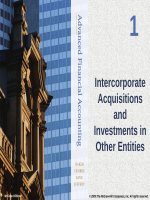Advanced financial accounting by baker chapter 01
Bạn đang xem bản rút gọn của tài liệu. Xem và tải ngay bản đầy đủ của tài liệu tại đây (2.76 MB, 40 trang )
1
Intercorporate
Acquisitions
and
Investments in
Other Entities
McGraw-Hill/Irwin
© 2009 The McGraw-Hill Companies, Inc. All rights reserved.
The Development of Complex
Business Structures
• Enterprise expansion as a means of
survival and profitability
– Size often allows economies of scale
– New earning potential
– Earnings stability through diversification
– Management rewards for bigger company
size
– Prestige associated with company size
1-2
Organizational Structure and
Business Objectives
• A subsidiary is a corporation that is
controlled by another corporation, referred
to as a parent company, usually through
majority ownership of its common stock
• Because a subsidiary is a separate legal
entity, the parent’s risk associated with the
subsidiary’s activities is limited
1-3
Organizational Structure, Acquisitions,
and Ethical Considerations
• Manipulation of financial reporting
– Usage of subsidiaries or other entities to
borrow money without reporting the debt on
their balance sheets
– Using special entities to manipulate profits
– Manipulation of accounting for mergers and
acquisitions
• Pooling-of-interests
1-4
Business Expansion and Forms of
Organizational Structure
• Expansion from within: New subsidiaries
or entities such as partnerships, joint
ventures, or special entities
• Motivating factors:
– Helps establish clear lines of control and
facilitate the evaluation of operating results
– Special tax incentives
– Regulatory reasons
– Protection from legal liability
– Disposing of a portion of existing operations
1-5
Business Expansion and Forms of
Organizational Structure
– A spin-off
• Occurs when the ownership of a newly created or existing
subsidiary is distributed to the parent’s stockholders without
the stockholders surrendering any of their stock in the parent
company
– A split-off
• Occurs when the subsidiary’s shares are exchanged for
shares of the parent, thereby leading to a reduction in the
outstanding shares of the parent company
1-6
Business Expansion and Forms of
Organizational Structure
• Expansion through business combinations
– Entry into new product areas or geographic
regions by acquiring or combining with other
companies
– A business combination occurs when “. . .
an acquirer obtains control of one or more
businesses”
– The concept of control relates to the ability to
direct policies and management
1-7
Business Expansion and Forms of
Organizational Structure
• Traditional view - Control is gained by
acquiring a majority of the company’s
common stock
• However, it is possible to gain control with
less than majority ownership or with no
ownership at all
– Informal arrangements
– Formal agreements
• Consummation of a written agreement requires recognition
on the books of one or more of the companies that are a
party to the combination
1-8
Frequency of Business
Combinations
– 1960s - Merger boom
• Conglomerates
– 1980s - Increase in the number of business
combinations
• Leveraged buyouts and the resulting debt
– 1990s - All previous records for merger activity
shattered
– Downturn of the early 2000s, and decline in mergers
– Increased activity toward the middle of 2003 that
accelerated through the middle of the decade
• Role of private equity
– Effect of the credit crunch of 2007-2008
1-9
Organizational Structure and
Financial Reporting
• Merger - A business combination in which
the acquired company’s assets and
liabilities are combined with those of the
acquiring company results in no additional
organizational components
– Financial reporting is based on the original
organizational structure
1-10
Organizational Structure and
Financial Reporting
• Controlling ownership - A business
combination in which the acquired
company remains as a separate legal
entity with a majority of its common stock
owned by the purchasing company leads
to a parent–subsidiary relationship
– Accounting standards normally require
consolidated financial statements
1-11
Organizational Structure and
Financial Reporting
• Noncontrolling ownership - The purchase of a
less-than-majority interest in another corporation
does not usually result in a business
combination or controlling situation
• Other beneficial interest - One company may
have a beneficial interest in another entity even
without a direct ownership interest
– The beneficial interest may be defined by the
agreement establishing the entity or by an operating
or financing agreement
1-12
Creating Business Entities
• The company transfers assets, and
perhaps liabilities, to an entity that the
company has created and controls and in
which it holds majority ownership
– The company transfers assets and liabilities to
the created entity at book value, and the
transferring company recognizes an
ownership interest in the newly created entity
equal to the book value of the net assets
transferred
1-13
Creating Business Entities
• Recognition of fair values of the assets
transferred in excess of their carrying
values on the books of the transferring
company is not appropriate in the absence
of an arm’s-length transaction
• No gains or losses are recognized on the
transfer by the transferring company
1-14
Creating Business Entities
• If the value of an asset transferred to a
newly created entity has been impaired
prior to the transfer and its fair value is
less than the carrying value on the
transferring company’s books, the
transferring company should recognize an
impairment loss and transfer the asset to
the new entity at the lower fair value
1-15
Forms of Business Combinations
• A statutory merger
– The acquired company’s assets and liabilities are
transferred to the acquiring company, and the
acquired company is dissolved, or liquidated
– The operations of the previously separate companies
are carried on in a single legal entity
• A statutory consolidation
– Both combining companies are dissolved and the
assets and liabilities of both companies are
transferred to a newly created corporation
1-16
Forms of Business Combinations
• A stock acquisition
– One company acquires the voting shares of another
company and the two companies continue to operate
as separate, but related, legal entities
– The acquiring company accounts for its ownership
interest in the other company as an investment
– Parent–subsidiary relationship
– For general-purpose financial reporting, a parent
company and its subsidiaries present consolidated
financial statements that appear largely as if the
companies had actually merged into one
1-17
Forms of Business Combinations
AA Company
AA Company
BB Company
(a) Statutory Merger
AA Company
CC Company
BB Company
(b) Statutory Consolidation
AA Company
AA Company
BB Company
BB Company
(c) Stock Acquisition
1-18
Determining the Type of Business
Combination
AA Company invests in BB Company
Acquires net
assets
Acquires stock
Yes
Acquired company
liquidated?
No
Record as statutory
merger or statutory
consolidation
Record as stock
acquisition and
operate as subsidiary
1-19
Methods of Effecting Business
Combinations
• Acquisition of assets
– Statutory Merger
– Statutory Consolidation
• Acquisition of stock
– A majority of the outstanding voting shares usually is
required unless other factors lead to the acquirer
gaining control
– Noncontrolling interest: The total of the shares of an
acquired company not held by the controlling
shareholder
• Acquisition by other means
1-20
Valuation of Business Entities
• Value of individual assets and liabilities
– Value determined by appraisal
• Value of potential earnings
– “Going-concern value” based on:
• A multiple of current earnings.
• Present value of the anticipated future net cash flows
generated by the company.
• Valuation of consideration exchanged
1-21
Accounting for Business
Combinations
• Two methods acceptable earlier:
– Purchase
– Pooling of interests
• 2001 - the FASB eliminated pooling of interests
• 2007 - FASB 141R replaced the purchase
method with the acquisition method
– This must be used to account for all business
combinations for which the acquisition date is in fiscal
years beginning on or after December 15, 2008
– FASB 141R may not be applied retroactively
1-22
Acquisition Accounting
• The acquirer recognizes all assets
acquired and liabilities assumed in a
business combination and measures them
at their acquisition-date fair values
– If less than 100 percent of the acquiree is
acquired, the noncontrolling interest also is
measured at its acquisition-date fair value
• Fair value measurement
– The FASB decided in FASB 141R to focus
directly on the value of the consideration
given
1-23
Acquisition Accounting
• Points to consider:
– No separate asset valuation accounts related
to assets acquired are recognized
– Long-lived assets classified at the acquisition
date as held for sale are valued at fair value
less cost to sell
– Deferred income taxes related to the business
combination and assets and liabilities related
to an acquiree’s employee benefit plans are
valued in accordance with the relevant FASB
standards
1-24
Acquisition Accounting
• Points to consider:
– Costs of bringing about and consummating a
combination are charged to expense as
incurred
– Costs of issuing equity securities used to
acquire the acquiree are treated as a
reduction in the paid-in capital associated with
the securities
1-25









